Haswell and GK110 vs. Ivy and GK104: DigitalStorm Virtue System Review
by Dustin Sklavos on June 23, 2013 12:00 PM ESTSystem and Gaming Performance
The two subjects we want to examine with the DigitalStorm Virtue and its 4.4GHz Intel Core i7-4770K are whether or not the overclocking plateau really has stayed level over the past two or three generations of Intel CPUs, and just how close GK104 can really get to GK110. Remember that the GeForce GTX 770 actually ships with memory clocks higher than most GTX 680s could attain, and memory bandwidth was frequently the bottleneck with GK104.
An important comparison to keep in mind: the 4.6GHz Intel Core i7-3770K is only clocked about 5% faster than the new 4.4GHz i7-4770K. Haswell tends to be roughly 10% faster clock per clock than Ivy, so with some dirty math it would take about a 4.8GHz i7-3770K to make up the performance gap.
As for the overclocked GTX 680 against the GTX 780, that's a bit trickier. The 780 is working with almost 50% more memory bandwidth, and with some extremely dirty math, about 20% more shader power. That's before you try to calculate the GTX 780's boost clocks, which are much jumpier than the GTX 680's. Even missing an entire SMX cluster, GK110 is still a bear compared to the more svelte GK104.
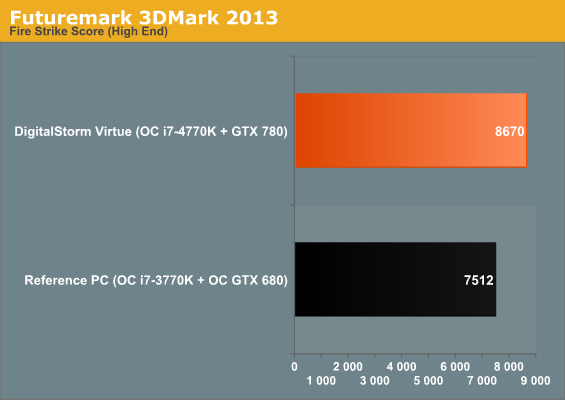
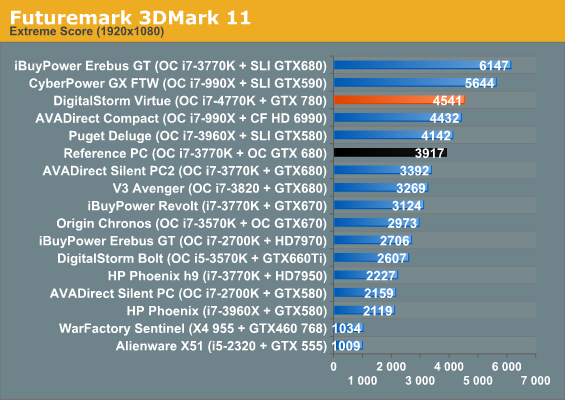
The 3DMarks pretty much tell the story. In both 3DMarks, a stock 780 is still ~15% faster than a heavily overclocked GTX 680.
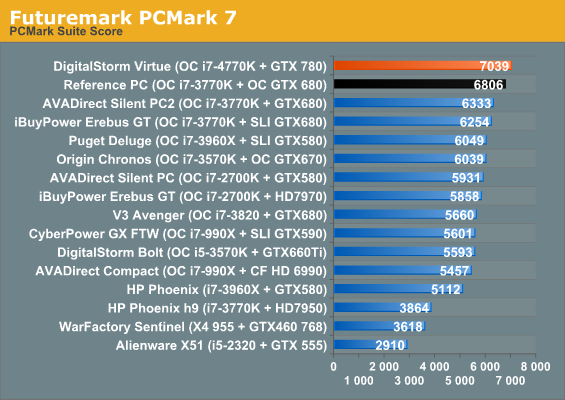
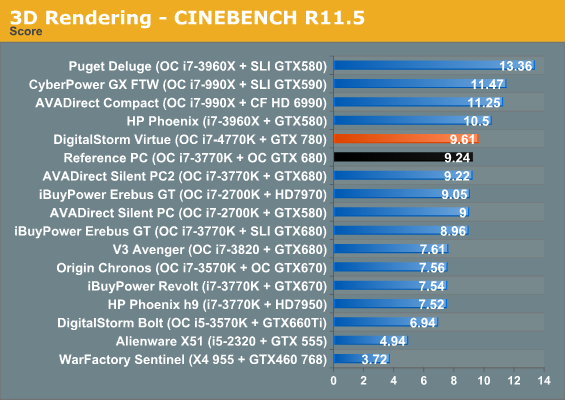
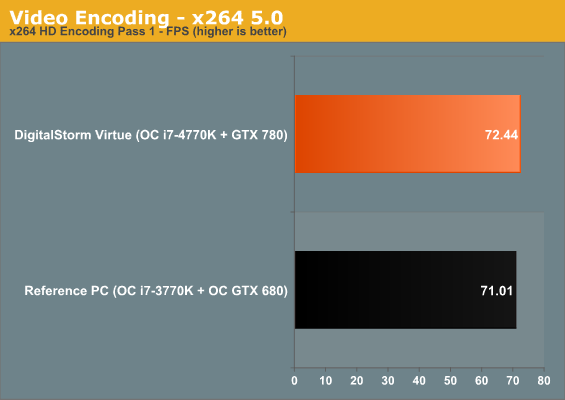

While PCMark7 tends to simply favor newer, faster SSDs, the difference between Haswell and Ivy gets a lot uglier when we isolate CPU performance. Consensus is that we've lost a bit of overclocking headroom with Haswell, making the comparison between a 4.6GHz Ivy and 4.4GHz Haswell a reasonably fair one. Cinebench is just 5% faster on Haswell, the first pass of the x264 benchmark is a dismal 2% faster on Haswell, and the second pass is at least a slightly healthier 7%.
Also note the improvement from Sandy to Ivy in Cinebench, though: our fastest Ivy is just 2% faster than our fastest Sandy. That Sandy was also running at 4.6GHz. Ivy at least brought a fat reduction in power consumption and TDP from Sandy despite the mediocre IPC improvement, but Haswell actually increased power consumption.
The math gets even uglier when we compare Sandy to Haswell. A 4.4GHz i7-4770K is only 6% faster than a 4.6GHz i7-2700K. That means that in two subsequent generations, the performance ceiling has barely moved. Anand is keen to point out that Intel's ability to eke out ~10% additional IPC on the same 22nm process node with a new architecture is impressive, and that may be true from a technical perspective, but Intel has offered enthusiasts virtually nothing new for two generations running. So whether or not the technical achievement is notable, end users are still left holding the bag. At this point, if you're hankering for more performance on the CPU, your best bet is actually to either go for an i7-3930K or wait for Ivy Bridge-E and hope Intel doesn't bone us with thermal paste instead of fluxless solder again. The only real selling point of Haswell, as far as I'm concerned, is access to the Z87 chipset.
Thankfully, while the jump in price from the NVIDIA GeForce GTX 680 to the GTX 780 isn't a particularly happy one, at least that dial moved pretty substantially. We tested every game at our Enthusiast settings (essentially maxed out and topping out at 4xMSAA), at 1920x1080 and then at 5760x1080.
|
GTX 680 1080p |
GTX 780 1080p |
% Perf. Increase |
GTX 680 Surround |
GTX 780 Surround |
% Perf. Increase |
|
| BioShock Infinite | 83.1 | 91.6 | 10.2% | 32.5 | 37.1 | 14.2% |
| Elder Scrolls V: Skyrim | 93.4 | 104.1 | 11.5% | 72.1 | 75.7 | 5% |
| GRID 2 | 87.3 | 109.2 | 25.1% | 39.4 | 49.2 | 24.9% |
| Metro: Last Light | 36.7 | 40.7 | 10.9% | 13.7 | 15.7 | 14.6% |
| Sleeping Dogs | 90 | 101.2 | 12.4% | |||
| StarCraft II: Heart of the Swarm | 73.5 | 86.2 | 17.3% | |||
| Tomb Raider | 64.3 | 72.5 | 12.8% | 31.8 | 36.5 | 14.8% |
So how do we interpret these results? First, excluding the outlying Skyrim surround results, even a diehard overclocked GTX 680 user can expect to net at least 10% more power from the GTX 780. Bumping up to 5760x1080 actually even lets the GTX 780 start to stretch its legs; while the 680 seems to be limited either by memory capacity or memory bandwidth, the 780's 384-bit memory bus and extra 1GB of GDDR5 do a solid job of picking up the slack.
Remember, too, that this is all before you overclock the 780. The consensus right now seems to be that the 780 has a very healthy amount of overclocking headroom, more than the 680 did, so if you're willing to sacrifice some power consumption and noise, you can theoretically push the 780 to Titan levels and even a bit beyond. At that point, it will pull away substantially from the 680 and by extension, the 770. I'm planning to do a custom liquid cooling review in the near future to get a grasp of just how far we can reasonably push a pair of GTX 780s, and given that I regularly see boost clocks of about 1GHz on them with just air cooling and no overclocking, I'm pretty optimistic.










70 Comments
View All Comments
cmdrdredd - Sunday, June 23, 2013 - link
Nice review. I too am unimpressed by Haswell, but even more unimpressed by the GTX 770. Basically an overclocked 680. Only the 780 is even worth mentioning IMO. That's just my opinion and since I am on SLI 670s I suppose my view is a little unfair.That all said these systems offer pretty good value for someone who wants a ready to go system right out of the box with no fuss. The pricing is extremely fair.
airmantharp - Monday, June 24, 2013 - link
The GTX770 is worth mentioning for the blower- it uses the Titan/GTX780 blower instead of the GTX680 blower. Lower temps, less noise, especially when pushed.But otherwise, you're right, it's unremarkable.
HisDivineOrder - Monday, June 24, 2013 - link
Actually, very few of those 770's with the Titan blower were made. Fewer still are being sold. In the US, they're all coming with custom coolers.sticks435 - Tuesday, June 25, 2013 - link
Evga is now bringing out a limited run of them, though with a higher price.kilkennycat - Wednesday, June 26, 2013 - link
Really ?? The only GTX770 with blower-style coolers listed on the US eVGA website as of 06/26 all have GTX680-type coolers, no Titan cooler.The Titan cooler requires a physical redesign of the GTX680 circuit board to accommodate the mechanics. It seems very odd to me that the nVidia reference design of the GTX770 sports the Titan cooler, but none of the partner-manufacturers offer that cooler as an option. I suspect that excess GTX680 circuit-board material and component inventory is currently being reallocated to GTX770 by installing the updated GK104 silicon and Boost2.0 firmware. Presumably after that material is used up, then Titan-style GTX770 may appear, probably at some price premium.
MattKatz - Thursday, October 9, 2014 - link
I'm not impressed by either one. The CybertronPC Borg-Q GM4213C is much better. /Matt from http://www.consumertop.com/best-desktop-guide/HisDivineOrder - Monday, June 24, 2013 - link
Hm. You're forgetting the price argument about the 770.The 770 isn't just an overclocked 680. It's an overclocked 680 at former 670 pricing. So not only are they giving you more than top end performance from the last card line, but they're selling it to you for $100 less.
Meanwhile, Haswell is nothing but absolute disappointment for the desktop user. Even for the laptop user who isn't buying an Ultrabook, I question much of its value. Haswell makes the most sense in Ultrabooks and in Razer Edge-esque tablets.
IanCutress - Sunday, June 23, 2013 - link
Wow, I didn't realise the Gryphon came with the ALC892. Would have assumed an ALC898 minimum. I would guess the money on that motherboard was spent on the TUF features first before the audio.Seems a little odd for a boutique build that ASUS is chosen for the motherboard, ASUS for the ODD, then EVGA with the GPU. Why not keep it all one company? Same with the memory - the case and PSU are Corsair, but the memory is ADATA? I'd assume that 'cost at the time' is the answer, but $2500 seems a lot for the whole system, or is that just me? [Insert self-build takes time over pre-built hence extra 10% on cost]
Dustin Sklavos - Sunday, June 23, 2013 - link
The margin on this build is actually a very reasonable one, comparatively. We're looking at probably around or a bit less than the 10%.aruisdante - Sunday, June 23, 2013 - link
Because EVGA' 1150 boards aren't out yet. It is odd they went with the Gryphon instead of the Genethough.